Traditional Stone Carvers Preserving Art and Hunger in Bihar
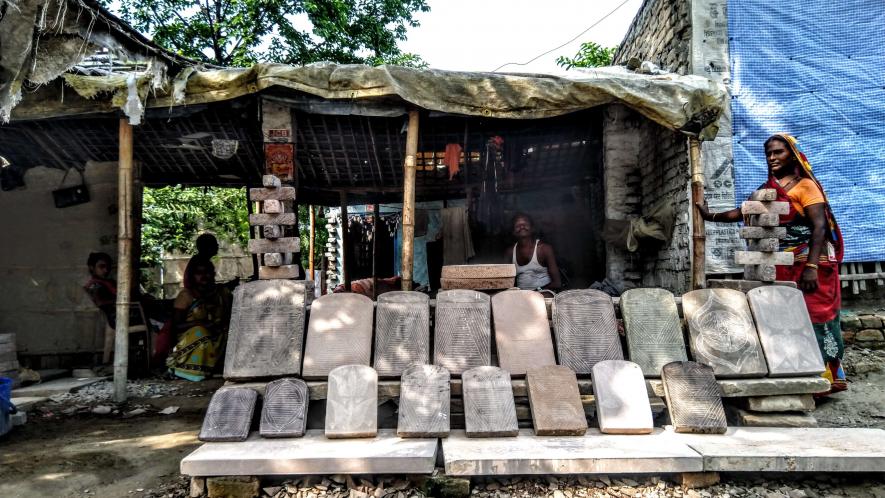
The home [left] adjacent to Lalbabu’s was demolished after the occupants spoke to the media last year while Lalbabu is left with meagre resources [right] to earn for a living.
Lalbabu Kanjar, in his late fifties, is finishing his lunch—“a bowl of cooked rice and dal”. “The demand of silwat-lodha (mortar pestle) and jaanta chakki (wheel used for grinding wheat) has fallen with the advent of mills and mixer-grinder,” he says.
Tulsi Devi, daughter of Lalbabu, interrupts the conversation as she tries to stop Lalbabu from giving out any more information. She is scared as they have to face the wrath of the magistrate after the publication of the report. She says, “Last time a reporter came here, the neighbouring hut was crushed into pieces by the government two days later.”
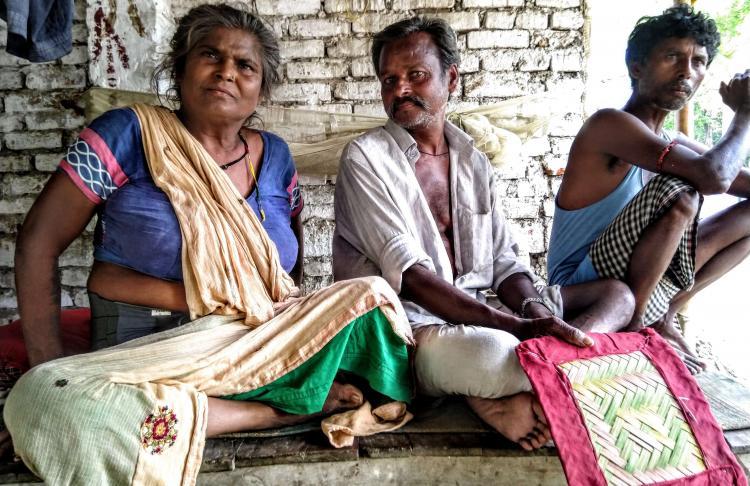
handa, Lalbabuand Ramji share the same distress that has affected their business of traditional stone carving.
Everyone sits silently, as this harsh truth sinks. Lalbabu suddenly starts recounting in a fumbling voice, “Where can we go?” His tone suddenly transforms, he adds, angrily, “Kahe na bulldozer chhatiye pe chala deta ee sarkar, sut jani san hamni ke jaminwa pe. Jiya aa marla, batwa barabare baa hamni la. (Why doesn’t this government run the bulldozer on us? Life and death are same for us.)” He was served notice last year on the day of Chhath festival to vacate the place.
To chisel stone slabs into mechanical grinders, also known as batán or sil-batta in many parts of India, and household stone horizontal flour mills, called jaanta chakki, is a traditional job for Lalbabu and some other hundred people who have been living since the days of colonial rule in the small at-grade junction stretch, located on the opposite side of the residence of District Collector of Paschim Champaran. The traditional stone carvers of Bihar, locally known as ‘kanjars’, are listed as Scheduled Caste but they are suffering greatly due to administrative negligence.
Apart from some stone slabs and silwat-lodha, Lalbabu only has a few hundred rupees in pocket and a thatched bamboo roof covered with a dilapidated plastic canvas; stinging sunlight perforates the roof, rainwater drips too. It has been months since he bought a new cloth. The land is not Lalbabu’s, same goes for the all of other landless community members here. Asked about visits of District Magistrate and officers from Social Welfare Department, Lalbabu says, “Yes, they come but only to evict us.”
Government’s Apathy
Rajesh Kanjar, brother of Lalbabu, showing the Aadhaar card and Electronic Photo Identity Card [issued for ward number 16 of Bettiah Municipality], tells that they have the registered address of the location but haven’t been allotted the land, thus, curtailing the residence funds under Pradhan Mantri Awaas Yojana (PMAY). Lalbabu and Rajesh make a joint family, living in an area of less than 50 sq. metres. The joint family not only saves the paltry income earned from stone carving but also it helps in reducing consumption of resources like cooking fuel. Basic amenities like cooking gas and clean water are considered as a luxury; people here are forced to cook on fire woods.
Rajesh says, “We couldn’t gather enough money to buy any arable or non-arable land some ten years ago when we were in a better position compared to this [present condition], how will we able to do it now under this pathetic situation?” The government offered a sum of Rs. 60,000 per family to buy a piece of land somewhere else in the district with the assurance of fund allocation for PMAY, but the occupants declined the offer saying that the amount offered was insufficient to buy even a dhur, equal to 17 sq. metres, of residential land in the town. “Kanjars”, Rajesh says, “will continue refusing to shift to any remote village as our business is meant for the urban area; to and fro transportation of heavy stone items is not feasible for the poor without any financial help.”
“The fall of our business happened in two phases, one with the arrival of automatic mills a decade ago and the second phase coincided with the rise of electronic mixer-grinder sale,” he adds.
The traditional carvers failed to sense the forthcoming age of technology; the attachment with traditional praxis played a major role in their financial downfall. Most of the old and middle-aged carvers were not comfortable with shifting to other forms of labour; and the administration has also failed to rehabilitate them.
Chanda Devi, a widow in her 60s, tells NewsClick that her relatives in Darbhanga have been given one katha of land. “Na bechala ta karja kadh ke khai le jaan (We have to borrow money on the days we fail to earn),” she says talking about the non-seasonal nature of the sale drop. Chanda suffered an elderly hip fracture and has to wear hip belt pads all the time. She defecates in open fields behind her hut; she also guides this reported to the backyard of her hut to show the remains of toilet built by the government. She says, “The wall fell into the toilet seat, no one came to repair. Do we have money to rebuild it? Other toilets met the same fate, gusty winds pardoned none.”
Chanda’s sons Upendra and Pappu have gone to Lauria, 27 kilometres away, to sell silwat-lodha and jaanta. They hire an auto-rickshaw on a one-way rent of Rs. 700 to transport the items. They are expected to return next month after selling all the items.
Ramji’s three-year-old son, Prince, recently recovered from a life-threatening cough. For his treatment, Ramji spent more than thousands of rupees, and was forced to beg on the streets of Bettiah and Motihari. “After the recovery, I don’t have enough money to feed him. The business is in tatters… I have no money to repair the roof ahead of rainy season,” he says. He is willing to sell the bicycle–the only vehicle he has–but not getting a good price for it. The best selling price offered to him was Rs. 2,000.
A priest assured Ramji of good fortune with some puja he performed in their hut last month. He says, “Nothing has happened yet. He robbed me of Rs. 151 in the name of god. His tantra mantra has failed.”
Fulkumari Devi also shares Ramji’s hut. Her husband left her several years ago to marry someone else. “I am living for my son…there is no other reason to live,” she says talking about her son, aged 12, who works on a meagre monthly salary of Rs. 500 in a car cleaning workstation in the town market. His earnings can afford only half a kilogram rice per day for his family.
Just then, a group of elementary school children can be seen coming towards Kanjar basti. Ramji’s daughter Vandini is in class 4. She wants to become a doctor. Asked why, she replies, “Doctors are the incarnation of the gods; they kill diseases and make us happy.” Vandini’s father says that she went to school hungry as there was nothing to eat at home.
Every child here wants to do something inspiring; change in new generation is visible. Roshni wants to become a police officer while Aditya dreams for a private job.
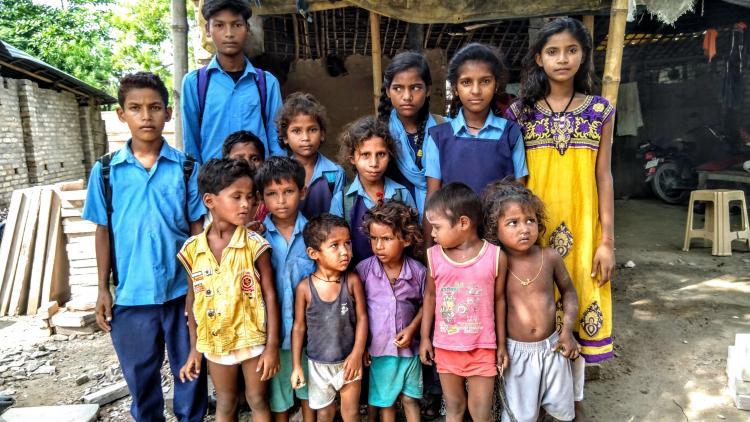
Kids in Kanjar community attend an elementary government school
Meena Kanjar sends her sons, who study in class 9 and class 4, to attend a private coaching institute in the town. She says, “The quality of Bihar’s education system is not hidden from anyone. What will they learn by just going to government school? Even the teachers hardly come.”
“My husband [Ramu Kanjar] is mentally ill. Now the responsibility of kids is on my shoulders,” she laments.
Carrying the heavy silwat-lodha(s) on her head and back, Meena goes to different areas in the Bettiah town and nearby villages to make a living. She also chisels the silwat-lodha(s) on demand, travelling across villages and going door to door.
Basanti Devi, in her early seventies, lives with the son of her brother. Her sons who have switched to daily wage labour live outside of the state with their families. She says, “We, Kanjars, have been doing this since ages. I will also die doing this while earning a few to leave behind so that my rites can be performed as I wish. I don’t want a life like this again.”
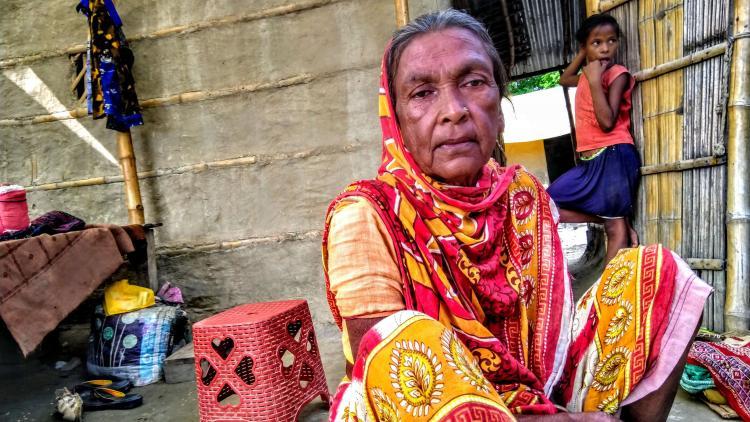
Basanti Deviâs sons live outside of the state, she chisels stones to earn
Rahul Kanjar, 18, passed class 12 examination this year. He is the second person in his family, after his brother, who will attend a college. He wishes to pursue Bachelors of Arts in History. He says, “It is certainly difficult to do both–studying and carving. I can’t see my father sweating profusely to earn for me. I can be his support.” Rahul tells that slabs are bought as a community stock, transported from Varanasi and Vindhyachal to here. He further says, “Three silwat-lodha(s) can be carved out of a metre long slab.” One metre slab costs Rs. 500 while a silwat-lodha is sold in the range of Rs. 200-300.
Rahul’s uncle Vijay, who has left stone carving, says, “I live in Nazni chowk area of the town, in a shop. In jobs like mine, one knows what one is getting by the end of the month. The earning in the business of stone carving keeps fluctuating; these days there is only a negative trend. I earn a little but that is consistent. How will I be able to feed my family if I remain solely dependent on tungai (stone carving)?”
As Raj Kumar, who studies in class seven in a government school, returns from school, he resumes the work of stone carving. Raj, serving as an apprentice, explains the deteriorating art of stone carving, “The stone slab is first cut into smaller ones with chabshi, the cold chisel. The small slabs are then carved into cuboid and torus shapes according to the need. Afterwards, slabs are designed with chenni, the bull point chisel.”
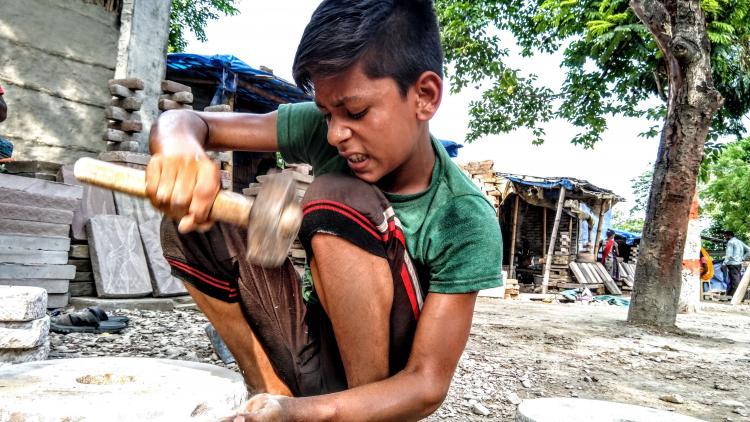
Raj Kumar finds a couple of hours per day to carve silwat-lodha after he returns from the school.
There are several silwat-lodhas with beautiful carvings lying in the shade of Raj Kumar’s home, waiting for customers.
Get the latest reports & analysis with people's perspective on Protests, movements & deep analytical videos, discussions of the current affairs in your Telegram app. Subscribe to NewsClick's Telegram channel & get Real-Time updates on stories, as they get published on our website.






















